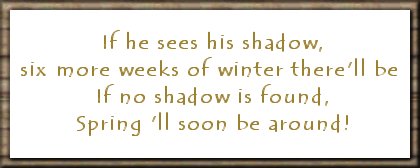Here Comes the Sun


![]()
Groundhog Day, February 2nd, is a popular tradition in the United States. It is also a legend that traverses centuries, its origins clouded in the mists of time with ethnic cultures and animals awakening on specific dates. Myths such as this tie our present to the distant past when nature did, indeed, influence our lives. It is the day that the Groundhog comes out of his hole after a long winter sleep to look for his shadow. If he sees it, he regards it as an omen of six more weeks of bad weather and returns to his hole. If the day is cloudy and, hence, shadowless, he takes it as a sign of spring and stays above ground. The groundhog tradition stems from similar beliefs associated with Candlemas Day and the days of early Christians in Europe, and for centuries the custom was to have the clergy bless candles and distribute them to the people. Even then, it marked a milestone in the winter and the weather that day was important. The roots of Groundhog Day go back to the 6th century. February 2 is 40 days after Christmas and is Candlemas Day in the Christianity. On this day candles that are used for the rest of the year were bless. This is also about the mid-point in winter, in weather not astronomical terms. Germans began trying to predict how long winter would continue based on the hibernation patterns of bears in this later part of winter. When some Germans settled in Pennsylvania they switched from bears to groundhogs -- which also hibernate. Why the switch I don't know. |
![]()


![]()
Groundhog's Day Links
Official Punxsutawny Groundhog's Day Site
Groundhog's Day Songs
Official Groundhog's Site
Groundhog's Day Info

© 1997-2006 lakebreeze@lakebreeze.org
[ Valentine's Day Page | St. Patrick's Day | Easter ]
Happy Groundhog sign from Celeste's Holiday Graphics
Groundhog border from Doc Holiday's Graphics
Other graphics made by me.
Last update on August 12, 2006
http://www.lakebreeze.org/holiday/groundhog.htm





